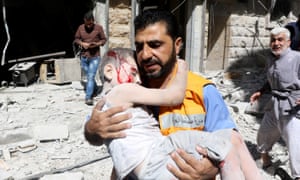Editorial

A child is rescued from a building in Aleppo after a Syrian army attack. ‘A humanitarian disaster of untold proportions’ is taking place in the city. Photograph: Anadolu Agency/Getty Images
Link
Aleppo is in the midst of what could be the most decisive battle in the Syrian civil war. If its rebel-held eastern areas fall to the regime, the anti-Assad opposition will lose its last strategic urban stronghold – and the diplomatic equation in the Middle East will likely shift entirely in favour of Russia and its allies. These include Iran, a very active participant in the fighting although it is mentioned more rarely than Russia, whose forces are leading the onslaught from the skies. For the 300,000-strong population under siege, however, the immediate reality is not so much a geopolitical development as a humanitarian disaster of untold proportions.
It says a lot that in recent days children have been filmed burning tyres in the streets to create a kind of homemade no-fly zone: a thick black smokescreen meant to impair visibility for bombing crews. People suffocate from the smoke, but hope that they are slightly less likely to be hit by the relentless airstrikes. There are also reports of inhabitants, including children, having been gassed by chlorine released by shells in rebel-held territory not far from Aleppo – a choice of target that points the finger at Syrian government forces. It puts another dent in the notion that the regime’s use of toxic gases in the war ended with the 2013 US-Russia negotiations over the dismantling of chemical weapon stockpiles.
The picture is not simple by any means. Rebel forces have gone on the counter-offensive since last Sunday to try to break the siege – and that operation is sowing its own amount of grief among civilians living in government-controlled areas. As it seeks to throw all available forces into the battle, the insurgency has harnessed the support of hardline jihadi groups based to the south-west of the city. This is a worrying turn, and it will further tarnish the opposition’s image. But it is too often forgotten that Aleppo’s anti-Assad “revolutionaries” aren’t just composed of armed combatants, but of thousands of families terrified of the Damascus regime. The empowering of the jihadi groups now leading the counter-attack is bad news for everyone.
The collapse of the “cessation of hostilities” agreement reached in February by Russia and the US had long been obvious. The only hope of ever getting President Bashar al-Assad’s power structure to talks under UN auspices hinged on the notion that the civil war had reached an impasse in which neither the regime nor the rebels could prevail. Russia’s open military intervention has in effect upended the diplomatic track. Iran, meanwhile, has capitalised on the absence of any strong western protests against its actions in Syria, whatever the death toll, confident that preserving a legacy-making nuclear deal is paramount for the Obama administration. Add to this equation the fact that Turkey, once a key supporter of Aleppo’s rebels, has recently warmed up its relations with Moscow (with the Kurdish factor in mind), and the plight of the city’s civilians resembles a long tunnel with no end in sight.
Western policies have failed in Syria, not least because they counted on hopes that Russia would become cooperative rather than aim for the full-blown military victory of its ally Mr Assad. The fate of Aleppo’s population hangs in the balance. So does the credibility of western strategies, which have focused solely on Islamic State and done too little to find a way to negotiate an end to the civil war, the worst human rights catastrophe of our time.

ugg boots, chanel handbags, polo ralph lauren outlet, ray ban sunglasses, oakley sunglasses, air max, tiffany and co, nike air max, louis vuitton outlet, gucci outlet, louis vuitton outlet, sac longchamp, nike free, nike free, longchamp, prada handbags, nike outlet, oakley sunglasses, louis vuitton, tory burch outlet, ralph lauren pas cher, ray ban sunglasses, tiffany jewelry, kate spade outlet, oakley sunglasses, uggs on sale, louis vuitton, longchamp outlet, replica watches, louboutin outlet, christian louboutin outlet, nike air max, louis vuitton, longchamp pas cher, louboutin shoes, ugg boots, longchamp outlet, ray ban sunglasses, louboutin pas cher, cheap oakley sunglasses, nike roshe run, louboutin, jordan shoes, burberry, prada outlet, air jordan pas cher, oakley sunglasses, replica watches, michael kors, polo ralph lauren outlet
ReplyDeletewedding dresses, mac cosmetics, chi flat iron, north face outlet, hollister, iphone cases, nike air max, babyliss, hollister, hollister, instyler, timberland boots, abercrombie and fitch, herve leger, birkin bag, mcm handbags, soccer jerseys, asics running shoes, nike air max, converse outlet, ray ban, valentino shoes, bottega veneta, louboutin, north face outlet, reebok shoes, nfl jerseys, vans shoes, insanity workout, baseball bats, longchamp, ghd, nike huarache, ralph lauren, nike roshe, celine handbags, converse, vans, lancel, soccer shoes, jimmy choo shoes, lululemon, oakley, beats by dre, new balance, mont blanc, p90x workout, ferragamo shoes, nike trainers, gucci
ReplyDelete